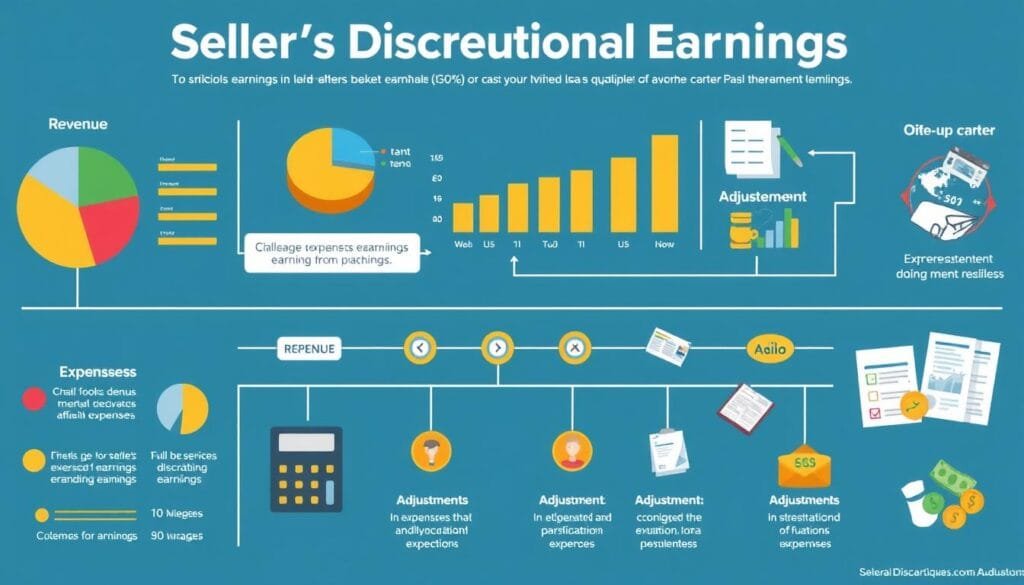Starting to price your business for sale? Valuing your business is key. This figure shows your hard work, financial strength, and market value. In this guide, we look at how to set the right sale price. We’ll cover EBITDA, SDE calculation, and other ways to value your enterprise.
There are many ways to value a business. You can count up assets, the foundation of market value1. Or use earnings multiples. This compares projected profit to industry P/E ratios12. The discounted cash-flow method calculates future financial health1. Location and strategic value to buyers can also change the price1.
Valuing small businesses often uses multiples of two to 10. This depends on size, profit history, and growth outlook3. Big companies may get higher multipliers from their market influence and stable income3. The right sale price blends these methods. It considers SDE for annual owner benefits2, specific industry multiples, and both tangible and intangible assets2.
Key Takeaways
- Comprehending the significance of valuing your business as a foundation for pricing.
- Understanding the diversity in valuation approaches, including SDE calculation and market valuation.
- Recognizing the impact of geographical location and strategic implications on business sale price.
- Considering complex methods like multiples of EBITDA to align with industry standards.
- Adopting a holistic perspective by noting the influences of both tangible and intangible assets.
- Emphasizing the necessity for accurate financial health representation through various metrics.
Understanding the Basics of Business Valuation
Understanding the value of a business is more than just number-crunching. It’s vital for making big decisions like investments or sales. Knowing a company’s worth helps guide its future direction.
What Makes Business Valuation Crucial?
Business valuation plays a key role in sales, mergers, and getting funds for growth. About 85% of valuations happen for these reasons. It’s crucial for making smart decisions and understanding a business’s true worth4.
The Role of Seller’s Discretionary Earnings (SDE) in Valuation
The SDE method is essential, especially for small and medium businesses. It takes into account the owner’s salary and personal costs, on top of EBITDA. This gives a clearer picture of profitability. Showing potential buyers the available cash makes deals more attractive4.
Improving Accuracy with Multiple Valuation Methods
Using various valuation methods improves accuracy. It combines income and market approaches. This mix helps give a fuller view by considering future earnings5 and comparable sales data5. It makes the valuation more reliable in a complex market.
| Company | Market Capitalization (Billion) | Liabilities (Billion) | Cash (Billion) | Enterprise Value (Billion) |
|---|---|---|---|---|
| Tesla | $50.5 | $17.5 | $3.5 | $64.56 |
| Ford | $44.8 | $208.7 | $15.9 | $237.66 |
| GM | $51.0 | $177.8 | $13.0 | $215.86 |
How to Prepare Your Financials Before Pricing
Before setting a price for your business, you need well-organized financial statements. It’s not just about ready numbers. It’s crucial these figures show your business’s true financial health. Accuracy in bookkeeping is essential.
Consolidating Financial Statements and Records
Merging various financial reports is key, like balance sheets and cash flow statements. Potential buyers often ask for up to five years of financial data for small operations78. You should organize these records month by month for the last three years. This makes them easy to access and understand8.
Choosing the right accounting method is also vital. Businesses might wonder whether to use cash or accrual accounting. A CPA can help make sure your financials follow the rules and are well-documented. This can make selling your business smoother7.
Distinguishing Between Essential and Discretionary Expenses
Knowing which expenses are critical and which are extra is crucial. Be sure to separate necessary costs from optional ones. Cutting out non-essential personal expenses can show a truer earnings figure7. It’s also smart to take non-operating assets off the balance sheet. This helps tidy up your assets for buyers7.
Showing these costs correctly matters a lot. A clear profit and loss statement can help buyers. It lets them see how the business has done over the years. Remember, pro-forma projections are just guesses and should be treated as such8.

Financial prep and good bookkeeping do more than meet buyer needs. They build a trustworthy and professional image. This can even help you get a better price. Proper financial preparation, clear expense shows, and detailed cash flow analysis are vital for a good sale.
How to Price a Business for Sale
When you’re ready to sell my business, knowing different business pricing strategies is key. These strategies help you find the right price. First, look at how profitable your company is and its cash flow projection. Then, you can pick the best way to set your price based on this info.
Companies making good money and growing sales tend to be worth more. This is because they’re seen as less risky and more likely to last9. Also, using a sales multiplier to look at current sales helps set a competitive price10.
“Every business’s value significantly hinges on its ability to generate revenue and sustain growth over the long term.”
- Checking out your competition and the market is key to valuing your business right9.
- Where your business is and how much people want what you’re selling matters too9.
- Getting help from experts can make sense of complex data for a solid valuation9.
The size of your business and what it owns play a big role in its price. Things like buildings, machines, ideas, and reputation are looked at9. Bigger, stable businesses can often ask for more money11.
Choosing between income, market, and asset-based valuation depends on your business’s story9. For those with lots of assets but up-and-down income, asset-based might work best9.
| Valuation Method | Description | Typically Used For |
|---|---|---|
| Asset-based | Summing tangible and intangible assets minus liabilities | Stable businesses with significant tangible assets |
| Market | Comparison with similar businesses recently sold | Businesses in competitive and transparent markets |
| Income | Based on future cash flow projections | Businesses with fluctuating revenues |
Finding a business’s worth involves many steps. Accurate cash flow projection, market analysis, and expert advice all play their parts. Doing this makes sure the price is right, leading to successful sales910.
Exploring Seller’s Discretionary Earnings (SDE) Method
The SDE method helps to accurately value small businesses. It does this by focusing on the owner’s real earnings. Especially for businesses making less than $5 million, this method is very insightful.
Steps to Calculate Your SDE
Start calculating SDE by looking at the business’s net income on tax returns. Then, add back any costs that only the owner incurs. This includes their salary, one-time expenses, and spending not related to day-to-day operations12. These steps change the basic net income into a true profit measure.
The Importance of Accurate SDE Calculation
Getting the SDE calculation right is very important. It makes sure financial statements show what a business truly earns. This impacts financial analysis, letting owners and buyers discuss value based on real figures12.
Industry-Specific Multiples and Their Impact
Different industry multiples greatly affect business value. Content businesses usually go for about 1.95x SDE. On the other hand, SaaS businesses can sell for up to 2.7x SDE. This shows the varying risks and growth chances in each industry13. Knowing these details helps in setting fair prices during sale talks.
It’s important to pick an SDE multiplier that matches the risk and market trends in your industry14.
| Industry | Average SDE Multiple |
|---|---|
| Content Businesses | 1.95 |
| eCommerce | 1.85 |
| SaaS | 2.7 |

Advanced Valuation Techniques for Your Business
If you plan to sell or just understand your business better, learning advanced valuation methods is key. These include looking at future money flows, comparing your business to others, and evaluating assets. Each method highlights different strengths, giving you a detailed view of your company’s value.
The Discounted Cash Flow Method Explained
The discounted cash flow (DCF) method is a detailed way to value a business based on future cash. It’s best for businesses with steady money coming in over years. You figure out future cash, adjust it to today’s value, and get a clear financial snapshot of your business15.
When to Use the Market-Based Valuation Approach
Use market-based valuation to compare your company with others in your field. This method sets prices and sees where you stand in the market by looking at similar sales. It works well when there are many businesses like yours to compare against15.
Selecting the Right Valuation Method for Your Business
Picking the right valuation way depends on how your company works, your future plans, and your industry. Think about how old your business is, its place in the market, and how people see your brand. This helps decide if you should look at assets, market comparisons, or future cash flows for valuation15.
Asset-based valuation fits best for companies with lots of physical or intangible things. But it might not work for firms focused on services15. If your business gets steady money and you can predict its growth, then using the DCF method could be right16.

- Discounted Cash Flow: Best for predictable revenue streams.
- Market Comparisons: Ideal for companies in competitive industries.
- Asset Valuation: Suitable for asset-intensive sectors.
In the end, knowing and using advanced valuation methods is crucial for understanding your business’s true value. By mixing methods like DCF or market comparisons, you can align the valuation with your unique market position and future outlook1516.
Maximizing Your Business’s Sale Price
To get the best price for your business, you need to make it financially strong and efficient. By improving these areas, your business becomes more appealing to buyers. This can help you get a better price.
Strategies to Enhance Financial Performance
Boosting your business’s financial health is key to getting a good sale price. Work on expanding how you make money and cut costs. This strengthens your financial standing. Showing how profits have recently gone up can draw in buyers17. A Quality of Earnings Report makes your financials clear and could raise your selling price17. Bad accounting could mess up financial reports. This makes valuing and selling your business harder17.
Improving Business Operations and Efficiency
Enhancing how your business runs is vital for attracting buyers. Make processes streamlined to up productivity. Deal with things that could disrupt operations, like relying too much on one person or a few clients. This makes your business more reliable and could improve its value17. Handling these issues protects your business from problems after selling. It helps keep things running smoothly.
Adjusting for Market Trends and Business Cycles
Knowing market trends and economic cycles helps you sell at the right time. Sales of businesses often go up during tough economic times18. By understanding these patterns, you can sell faster. Using market-based valuation helps compare your business to others. But, you need to be careful about market conditions and finding similar businesses to compare with18.
Check out this detailed guide for more tips on pricing your business for sale. It’s full of advice on how to value and prepare your business for selling.
Conclusion
Pricing your business for sale involves a lot of details. It requires understanding your finances, the market, and where your company stands among competitors. You need to analyze everything carefully to set a successful sale in motion19. It’s crucial to adjust and normalize financial statements. This shows the real profit your company can make19. Also, having varied customers, clear procedures, and a solid marketing plan is key for a good sale price19.
Choosing the right way to value your business is important19. There are several methods, like looking at assets, market trends, or income. Each one provides different insights. For instance, the market approach uses data from similar sales, and the income method evaluates how much money you can make and the risks19. You also need to decide on the detail level of your valuation. Simple calculations cost less, but full evaluations are also respected and can be worth it20.
Your goal is to close a deal that matches your business’s true worth19. You want to attract buyers who understand the value of what you’re offering. Choosing the right valuation method is crucial, whether you’re selling, dealing with legal stuff, or planning for the future20. This knowledge helps business owners proceed with confidence. They can ensure they’re setting up not just for a sale, but for handing over their life’s work fairly and in line with their dreams.
FAQ
What is the importance of valuing your business for a sale?
Valuing your business the right way is crucial. It helps set a fair price, ensuring you get what your company is worth. It also guides investment decisions and shows its financial strength to buyers.
How does Seller’s Discretionary Earnings (SDE) affect business valuation?
Seller’s Discretionary Earnings (SDE) is important, especially for smaller companies. It fine-tunes profits by including the owner’s salary and any extra costs. This offers a clearer view of a company’s earnings for buyers.
Why is blending different valuation approaches recommended?
Mixing various valuation methods, like the SDE and market-based, offers a fuller valuation. This blend considers a business’s finances and market standing. It appeals to diverse buyers and investment needs.
What kind of financial preparation is needed before pricing a business for sale?
Before setting a price, prepare by organizing your financial records and updating your bookkeeping. Analyzing cash flow and distinguishing between necessary and extra expenses presents a true financial snapshot to potential buyers.
What strategies can be used to determine a business’s sale price?
To set a sale price, use a detailed plan. This includes evaluating the market, financial health, cash flow, and market demand. Such planning makes your business more desirable to buyers.
Can you explain the steps involved in the SDE calculation process?
To figure out SDE, start with EBITDA. Then add the owner’s salary and extra expenses to show possible earnings. Pick an industry-suited SDE multiplier, apply it to the adjusted SDE to find your business’s worth.
Why is accurate SDE calculation critical?
Accurate SDE calculation is key. It considers all benefits to the owner, crucial for setting a true price. It shows the real earning potential to buyers.
How do industry-specific multiples impact business valuation?
Industry-specific multiples offer a comparison standard, showing risk and profit expectations. They help match your business’s value to similar companies.
What is the Discounted Cash Flow method, and when is it used?
The Discounted Cash Flow (DCF) method estimates a company’s value by foreseeing cash flows and bringing them to today’s value. It suits businesses with stable cash flows or those valued mainly for their income over time.
When should a market-based valuation approach be used?
Use a market-based valuation when you have data on similar business sales. It sets a value in line with the market, using sales figures from your industry.
How do you select the right valuation method for your business?
Choosing the right valuation method depends on your operation, growth outlook, and industry. A fitting method gives a true picture of what your business might earn and its market standing.
What strategies can help maximize my business’s sale price?
To boost your sale price, diversify income, cut costs, grow your share, enhance efficiency, and follow market trends. These steps improve your business, making it more appealing to buyers.
How can adjusting for market trends and business cycles affect a sale?
Adjusting for trends and cycles shows buyers your business can thrive despite economic changes. It can lead to a higher selling price and make your company a more tempting investment.
